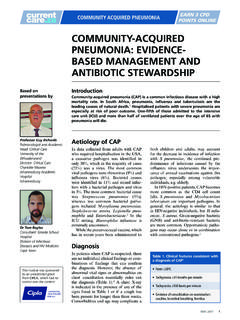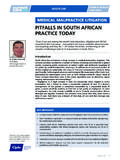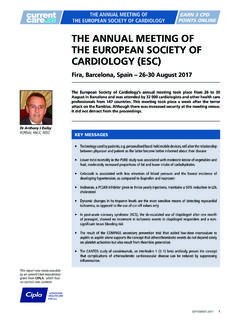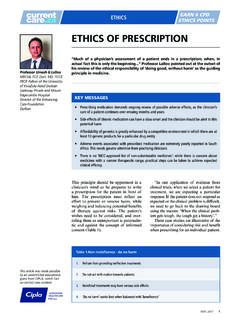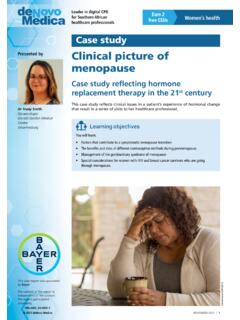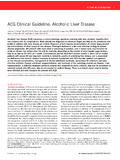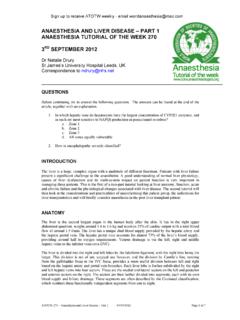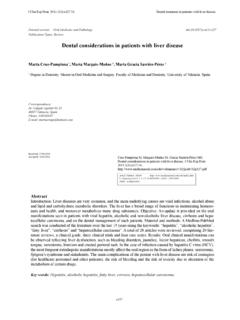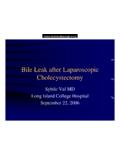Transcription of treatment of non-alcoholic fatty liver diSeaSe (nafld)
1 1earn 3 cpd pointS onlinenon-alcoholic fatty liver diSeaSe ( nafld )September 2016treatment of non-alcoholic fatty liver diSeaSe ( nafld )introductionnon-alcoholic steatohepatitis (naSh) or non-alcoholic fatty liver diSeaSe ( nafld ) was rare in the 1980s when the first series of 20 patients was published; cases which were gathered over many today, in clinical rounds in any private hospital in South africa, you will encounter many patients who have nafld , in association with other co-morbidities, dr aslam amod, endocrinologist, pointed out to delegates attending the fcp congress in cape town recently.
2 KEY MESSAGES nafld is a continuous spectrum of disorders; patients can progress or regress from non-alcoholic fatty liver (NAFL) (isolated hepatic steatosis/simple fatty liver with or without inflammation), to non-alcoholic steatohepatitis (NASH) with varying degrees of fibrosis, or progress to cirrhosis Patients with cirrhosis are at increased risk of death and hepatocellular carcinoma and high-risk symptomatic patients should be screened Obesity is the major cause of the increase in prevalence of nafld worldwide (although the condition does occur in lean people)
3 nafld is an independent risk factor for features of the metabolic syndrome and cardiovascular events The main clinical aim is to prevent progression of NAFL to fibrosis of the liver and further liver damage Intensive lifestyle modification/weight loss is a proven therapy While there are no drugs registered specifically for the treatment of nafld , drugs which can be used, in the absence of contraindications, are: Pioglitazone for type 2 diabetic patients Liraglutide for diabetic patients who cannot take pioglitazone Vitamin E for non-diabetes patients without cirrhosis Pentoxifylline for non-diabetic patients who cannot take vitamin Aslam AmodEndocrinologistDurbanThis report was made possible by an unrestricted educational grant from Cipla, which had no control over content.
4 Evidence is accumulating that nafld is not a benign condition. non-alcoholic fatty liver diSeaSe ( nafld )2 September 2016earn 3 cpd points on Accredited CPD modules . nafld is an all-encompassing descrip-tion of liver diSeaSe associated with excess fat deposition in the hepatocytes, in the absence of excessive alcohol use or other causes (viral, autoimmune or iron overload). The spectrum of nafld from its mildest to its most severe form includes NAFL usually without inflam-mation, NASH with or without fibrosis, and cirrhosis. Patients with cirrhosis are at increased risk of death and hepatocel-lular is the mildest form of this dis-ease, characterised by macrovesicular steatosis with mild inflammation and without cellular injury.
5 Evidence is accu-mulating now that this condition may not be so benign and may progress to further cellular injury, fibrosis and inflammation ( NASH) in at-risk patients, Dr Amod noted (Figure 1).figure 1. non-alcohol fatty liver diSeaSe ( nafld )naflnaShfibrosisliver transplantcirrhosishepatocellular carcinoma (hcc)2-3%/year15 25%30 40%15 20%deathThe development of NASH is the flash point and is characterised by fatty changes, cellular injury (ballooning, degeneration or necrosis) with or without fibrosis (most frequently in the presinu-soidal area of the liver ).
6 This is one step before cirrhosis with its broad collagen bands and extensive cellular destruction, Dr Amod noted. At this stage, earlier evidence of NAFL is no longer histologi-cally visible, hence the term: cryptogenic cirrhosis . With a global increase in body weight, the prevalence of nafld is also on the increase. In the general US popula-tion, 68% of individuals are obese or overweight and of these, 25-45% will have nafld and 3-6% NASH. Today, nafld is the most common type (75%) of chronic liver diSeaSe worldwide, Dr Amod This increasing preva-lence of nafld parallels the increase in visceral obesity, type 2 diabetes and insu-lin resistance (Table 1).
7 3 Independent risk factors for develop-ing nafld include a family history, ethnicity and each of the elements of the metabolic syndrome (obesity, dyslipidae-mia, hypertension, insulin resistance and diabetes). nafld also runs in families, with 40% of cases related to inheritability after adjusting for other factors. Genetic vari-ation of the PNPLA3 (adiponutrin) gene has been shown to be associated with nafld ; other genes may also play a role. it is very likely that obesity is a causative factor. table 1. increasing prevalence parallelsnhaneS data1988-19941994-20042005-2008% nafld of chronic liver disease47%63%75%Visceral obesity35%48%52%Type 2 resistance23%32%35% non-alcoholic fatty liver diSeaSe ( nafld )3 September 2016earn 3 cpd points on Accredited CPD modules.
8 Relationship with obesity It is very likely that obesity is a causa-tive factor, as weight loss (excluding bari-atric surgery) rapidly reverses nafld , Dr Amod noted. The likelihood of devel-oping nafld increases in obese popu-lations; 40-80% will develop nafld as compared to 25-40% in the general population. With regard to morbidly obese patients (BMI >35kg/m2), 90-95% will develop nafld . Lean people can also develop nafld , and in Asian populations, nafld occurs at lower BMIs than in Caucasian populations, Dr Amod pointed with type 2 diabetes and the metabolic syndromeThe prevalence of nafld in type 2 dia-betic patients is approximately 75%.
9 It is important also to note that patients with components of the metabolic syndrome (not including type 2 diabetes) are more likely to develop the more severe inflam-matory type of liver diSeaSe (NASH), rather than the more benign form (NAFL).4 The presence of nafld predicts met-abolic diSeaSe and adverse cardiovascular In fact nafld is a bet-ter predictor of cardiovascular mortal-ity than using the criteria that define the metabolic syndrome, Dr Amod pathophysiology of diSeaSe pre-dicted by nafld and the metabolic syn-drome is illustrated in Figure 2.
10 The clinical goal of treatment of nafld is to prevent progression to NAsh or cirrhosis. figure 2. the spectrum of diSeaSe predicted by nafld and metabolic syndromeNon-alcoholic steatohepatitisPredictors of fibrosis BMI, type 2 diabetes Insulin resistance PNPLA3 genotypeCirrhosisHepatocellular carcinomaCholesterol gallstonesDeep venous thromboembolismCardiovascular diseaseType 2 diabetes cell defectOverproduction of Glucose VLDL C-reactive protein, fibrinogen Coagulation factors CholesterolNoN-ALcohoLic fatty liver diSeaSe ( nafld )4 September 2016earn 3 cpd points on Accredited CPD modules.
